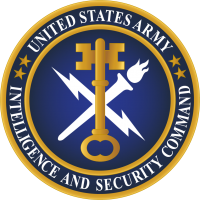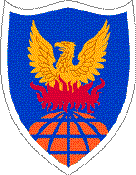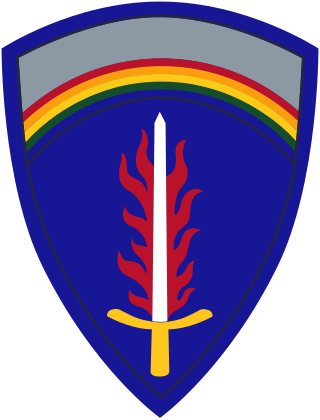
The XVIII Airborne Corps is a corps of the United States Army that has been in existence since 1942 and saw extensive service during World War II. The corps is designed for rapid deployment anywhere in the world and is referred to as "America's Contingency Corps." Its headquarters are at Fort Bragg, North Carolina.
United States special operations forces (SOF) are the special forces of the United States Department of Defense's United States Special Operations Command (USSOCOM) within the United States Armed Forces, used for special operations.

The United States Army Special Operations Command (Airborne) is the command charged with overseeing the various special operations forces of the United States Army. Headquartered at Fort Bragg, North Carolina, it is the largest component of the United States Special Operations Command. It is an Army Service Component Command. Its mission is to organize, train, educate, man, equip, fund, administer, mobilize, deploy and sustain Army special operations forces to successfully conduct worldwide special operations.

United States Strategic Command (USSTRATCOM) is one of the eleven unified combatant commands in the United States Department of Defense. Headquartered at Offutt Air Force Base, Nebraska, USSTRATCOM is responsible for strategic nuclear deterrence, global strike, and operating the Defense Department's Global Information Grid. It also provides a host of capabilities to support the other combatant commands, including integrated missile defense; and global command, control, communications, computers, intelligence, surveillance, and reconnaissance (C4ISR). This command exists to give "national leadership a unified resource for greater understanding of specific threats around the world and the means to respond to those threats rapidly".

Buckley Space Force Base is a United States Space Force base in Aurora, Colorado named after United States Army Air Service First Lieutenant John Harold Buckley. The base is run by Space Base Delta 2, with major units including the U.S. Space Force's Space Delta 4, the Colorado Air National Guard's 140th Wing, the Denver Naval Operations Support Center, and the National Reconnaissance Office's Aerospace Data Facility-Colorado.

The United States Army Civil Affairs and Psychological Operations Command (Airborne), USACAPOC(A), or CAPOC was founded in 1985 and is headquartered at Fort Bragg, North Carolina. USACAPOC(A) is composed mostly of U.S. Army Reserve Soldiers in units throughout the United States. The size of the Command is nearly 13,500 Soldiers, which is 76% of the Department of Defense's Civil Affairs forces and 63% of Psychological Operations forces. The current Commanding General is Major General Isaac Johnson Jr., who assumed command in August 2022.

The reorganization plan of the United States Army is a current modernization (2017–2028) and reorganization (2006–2016) plan of the United States Army that was implemented (2006–2016) under the direction of Brigade Modernization Command. This effort formally began in 2006 when General Peter Schoomaker, was given the support to move the Army from its Cold War divisional orientation to a full-spectrum capability with fully manned, equipped and trained brigades; this effort was completed by the end of 2016. It has been the most comprehensive reorganization since World War II and included modular combat brigades, support brigades, and command headquarters, as well as rebalancing the active and reserve components. The plan was first proposed by the Army's 34th Chief of Staff, Eric Shinseki, in 1999, but was bitterly opposed internally by the Army.

The 5th Signal Command (Theater) was a European-based tactical and strategic communications organization of the United States Army specializing in command and control which supported theater-limited, joint-forces, and combined forces activities. The command's mission was to build, operate and defend network capabilities to enable mission command and create tactical, operational and strategic flexibility for Army, Joint and Multinational forces in the EUCOM and AFRICOM areas of responsibility.

The United States Army Intelligence and Security Command (INSCOM) is a direct reporting unit that conducts intelligence, security, and information operations for United States Army commanders, partners in the Intelligence Community, and national decision-makers. INSCOM is headquartered at Fort Belvoir, Virginia.

The Estonian Defence Forces are the unified military forces of the Republic of Estonia. The Estonian Defence Forces consist of the Estonian Land Forces, the Estonian Navy, the Estonian Air Force, and the paramilitary Estonian Defence League. The national defence policy aims to guarantee the preservation of the independence and sovereignty of the state, the integrity of its land area, territorial waters, airspace and its constitutional order. Its main goals remain the development and maintenance of a credible capability to defend the nation's vital interests and development of the defence forces in a way that ensures their interoperability with the armed forces of NATO and European Union member states to participate in the full range of missions for these military alliances.

The structure of the United States Army is complex, and can be interpreted in several different ways: active/reserve, operational/administrative, and branches/functional areas.

U.S. Army Cyber Command (ARCYBER) conducts information dominance and cyberspace operations as the Army service component command of United States Cyber Command.

311th Signal Command Theater is the designated signal command for the Army Service Component Commands within the Pacific and Korean theaters. The staff of 311th Signal Command consists of more than 3000 active-duty soldiers, U.S. Army Reserve soldiers and Army civilians. Headquartered at Fort Shafter, Hawaii, the 311th SC(T) and its subordinate units are stationed across 16 time zones, ranging from Alaska to Korea, and from Hawaii to California.

Home-stationed at Clay National Guard Center in Marietta, the 78th Aviation Troop Command is the aviation arm of the Georgia Army National Guard.

The 780th Military Intelligence Brigade conducts cyberspace operations to deliver effects in support of Army and Joint requirements. The 780th MI BDE is the only offensive cyberspace operations brigade in the U.S. Army. The organization actively fights alongside its partners to achieve U.S. supremacy in cyberspace and in the electromagnetic spectrum.

United States Army Europe and Africa (USAREUR-AF) is an Army Service Component Command (ASCC) /Theater Army responsible for directing United States Army operations throughout the U.S. European Command (EUCOM) and U.S. Africa Command (AFRICOM) area of responsibility.

The 525th Expeditionary Military Intelligence Brigade (Expeditionary) is a unit of the United States Army specializing in the acquisition and analysis of information with potential military value. On 28 October 2014, the unit was reflagged from the "525th Battlefield Surveillance Brigade" to an expeditionary military intelligence brigade, the first of its kind.

The 151st Theater Information Operations Group, or 151st TIOG, is an Information Operations formation of the United States Army, headquartered at Fort Totten, New York. Founded in 2009, the 151st TIOG is the only Theater Information Operations Group in the U.S. Army Reserve. It is composed mostly of Army Reserve Soldiers in two battalions based out of Parks Reserve Forces Training Area, Fort George G. Meade, and Fort Totten. The current commander is Colonel Marlene Markotan, who assumed command in July 2019.

The Joint Communications Support Element (Airborne) (JCSE) is a United States Department of Defense (DoD) standing joint force headquarters expeditionary communications provider that can provide rapid deployable, en-route, early entry, and scalable command, control, communications, and computer (C4) support to the unified combatant commands, special operations commands, and other agencies as directed by the Joint Chiefs of Staff. On order, the JCSE can provide additional C4 services within 72 hours to support larger combined joint task force headquarters across the full spectrum of operations. JCSE is part of the Joint Enabling Capabilities Command (JECC), a subordinate command of the U.S. Transportation Command (USTRANSCOM).




















